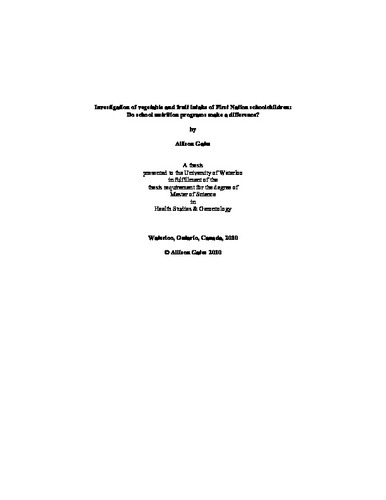| dc.description.abstract | Objectives: To investigate the vegetable and fruit, “other” foods, fibre, folate, vitamin A, and vitamin C intakes of
First Nations children and adolescents residing in seven communities in northern and southern Ontario, including
variations by year and community, and comparisons to current dietary standards and national averages based on age
and sex. Also, to implement and assess the impact of two school nutrition programs (in Kashechewan and Fort
Albany, Ontario) on dietary intakes of vegetable and fruit, “other” foods, fibre, folate, vitamin A, and vitamin C.
Also, to evaluate the two school nutrition programs, one a simple food provision program in Kashechewan, Ontario
and the other a more comprehensive school nutrition program in Fort Albany, Ontario, in terms of student and
teacher impressions and program integrity. For the program in Fort Albany, the impact of the program on nutrition
knowledge, self-efficacy, and intentions to eat more vegetables and fruit will also be assessed. Finally, to
investigate the association between Body Mass Index (BMI) and vegetable and fruit and fibre intake in First Nations
children and adolescents living on reserve in Ontario.
Methods: Dietary intakes were evaluated using 24-hour dietary recall data collected via the validated Web-Based
Eating Behaviour Questionnaire (WEB-Q) between 2003 and 2010 in seven First Nations communities in northern
(Attawapiskat, Fort Albany, Kashechewan, Moose Factory, and Peawanuck) and southern (Christian Island and
Georgina Island) Ontario. Vegetable and fruit, “other” foods, fibre, folate, vitamin A, and vitamin C intakes were
compared to current dietary standards and Canadian Community Health Survey Cycle 2.2 (CCHS). Yearly and
community differences in intakes were assessed using specific dataset pairs to control for season, year, and
community, where conditions were comparable. The association between vegetable and fruit and fibre intake and
BMI was investigated using the weight classifications described by Cole and colleagues (2000) and based on selfreported
heights and weights. The impact of a simple food provision program in Kashechewan First Nation was
examined in terms of vegetable and fruit, “other” foods, fibre, folate, vitamin A, and vitamin C intakes pre-, oneweek
post, and one-year post program using the WEB-Q. Finally, the impact of a comprehensive school vegetable
and fruit education program was evaluated in terms of vegetable and fruit, “other” foods, fibre, folate, vitamin A,
and vitamin C intakes, nutrition knowledge and preferences, and intentions and self-efficacy to eat more vegetables
and fruit pre- and post-program using validated questionnaires. Within each program, parent/guardian, student, and
teacher impressions of the program were evaluated via questionnaires and focus groups.
iv
Results: The majority of participants (n=443 students from seven communities) had intakes of vegetables and fruit
and relevant nutrients below current standards, with the exception of vitamin C. Mean intakes of vegetables and
fruit fell below Canadian Community Health Survey averages. Mean intakes of “other” foods exceeded vegetable
and fruit intakes in all age and sex groups in terms of servings. There was no significant association between
vegetable and fruit or fibre intake and BMI. In certain instances, significant variation in intakes existed between
different years and communities. Under ideal conditions (short-term, investigator-run portion of the program), the
school food provision program in Kashechewan First Nation produced improvements in vegetable and fruit intakes
(n.s.). Long-term intakes did not improve. Teacher and principal impressions of the program were overwhelmingly
positive. In the short term, the vegetable and fruit, relevant nutrient, and “other” foods intakes of students in Fort
Albany did not significantly change following a comprehensive school nutrition education program, and neither did
intentions or self-efficacy to eat more vegetables and fruit. However, the program resulted in significantly improved
nutrition knowledge, as well as significant improvements in the number of vegetables and fruit that participants had
been exposed to and liked. The majority of parents, teachers, and students had positive impressions of the program.
Conclusions: Overall, the dietary intakes of the study participants were characterized by poor intakes of vegetables
and fruit and intakes of “other” foods that exceeded vegetable and fruit intakes in all age and sex groups. Rates of
overweight and obesity were higher than those reported in the CCHS. With adequate resources and support, school
nutrition programs have the potential to improve the vegetable and fruit intakes of children and adolescents living in
the communities involved in this research. However, it is probable that the numerous barriers to healthy eating
identified in the communities examined blunted the positive effects of the program piloted in this study. Future
initiatives should include community-based approaches to improve accessibility of affordable, healthy foods of
reasonable quality. In conjunction with school nutrition programs, such programs may have the ability to positively
impact the dietary intakes of children and adolescents living on reserve in Ontario. | en |

